Summary: Fund flows out of equities and into the safety of bonds is the most extreme in more than 15 years. Retail investor bearishness is consistent with that at Christmas, early 2016 and other durable lows in equities.
Fund managers surveyed by BAML are similarly pessimistic. Their cash allocation is one of the highest in 16 years. Their equity allocation is the lowest since the bear market bottom in March 2009. And their allocation to bonds is near an 8-year high.
All of this suggests a continued upside tailwind for equities and a strong headwind for bonds. Could investors, especially fund managers, be right this time? Of course, but it's not likely. The last bear market started with strong equity inflows and bond outflows. Cash levels were relatively low. All of this is the reverse now.
The U.S. dollar is considered the most overvalued in 16 years, a possible tailwind for U.S. multi-nationals and ex-U.S. equities.
By most accounts, the fall in equities in May was exacerbated by investor fear. That fear does not appear to have dissipated with the rise in equities so far in June.
Let's review several recent studies of sentiment.
First, a study from Bernstein shows that flows out of equities and into bonds so far in 2019 is the most extreme in more than 15 years.
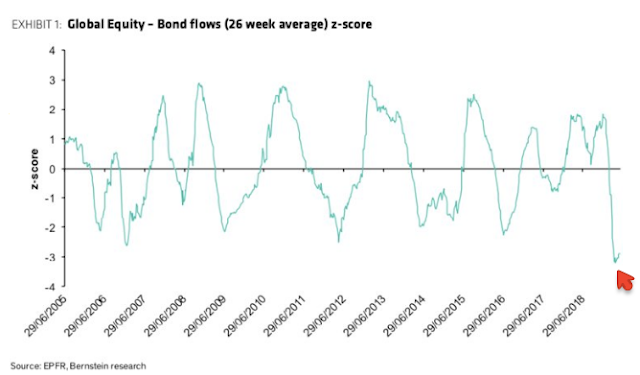
This is an outlier event more than 3 standard deviations from the mean. Prior instances are few but equities have done very well in the months ahead.
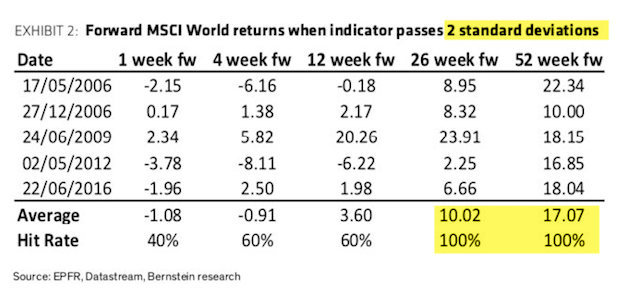
Those dates are highlighted in the chart below. This is not how bear markets, or even big corrections, begin.

Second, a similar view from Deutsche Bank on equity outflows - the largest on record - tells the same tale. Equities rose over 20% in the year following similar outflows in 2011 and 2016.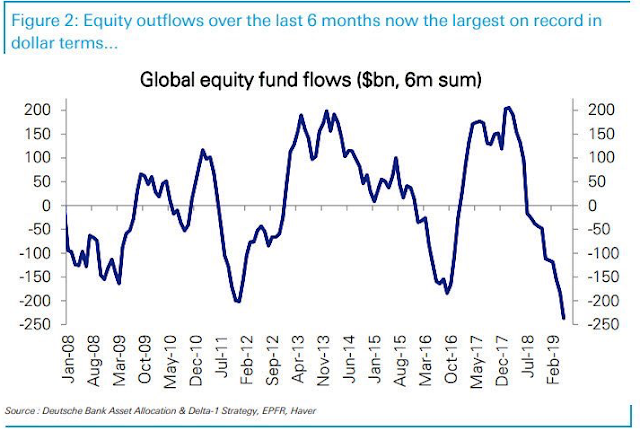
Third, retail investors polled by AAII were recently as bearish as they were at Christmas and in early 2016. Over the past 15 years, such bearishness has come at durable lows, with just two exceptions (red arrows), one of which was at the end of the 2-year bear market following the tech bubble.
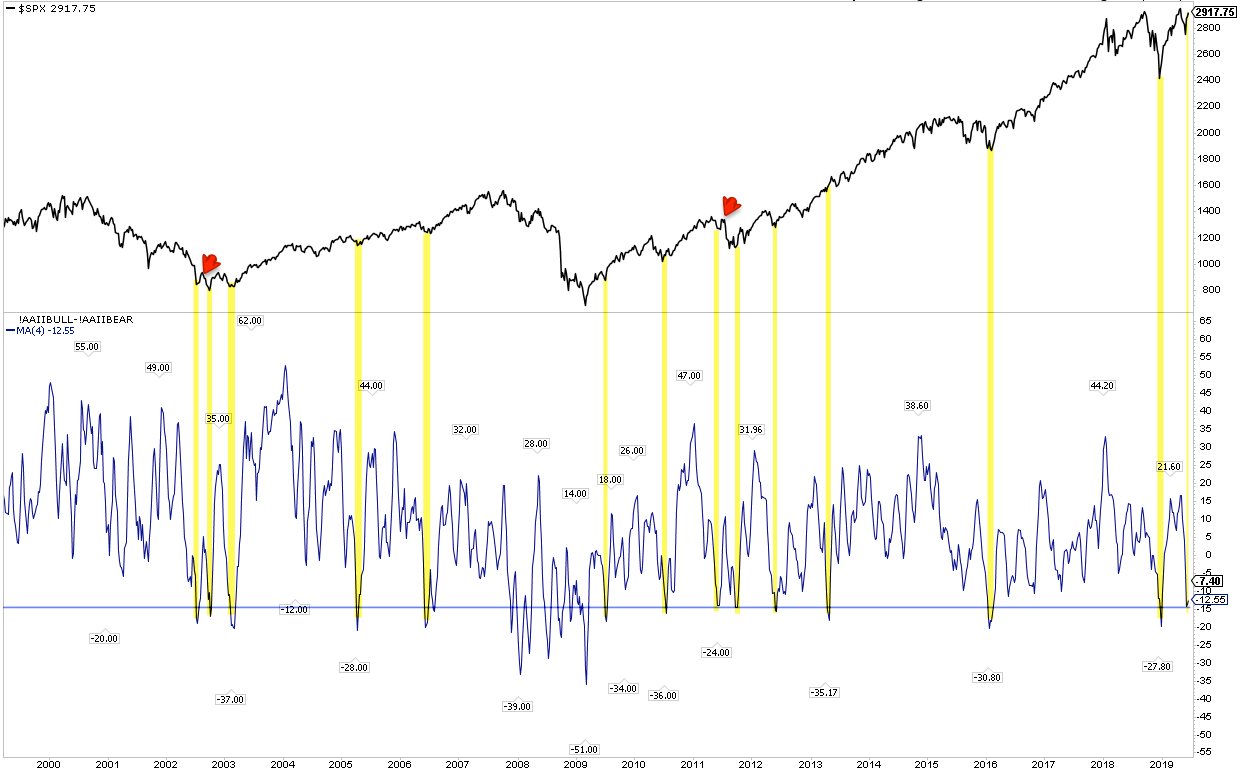
Fourth, this week's Bank of America Merrill Lynch (BAML) survey of global fund managers is consistent with the data presented above. These managers oversee a combined $600b in assets and their views reflect how managers are allocated in various asset classes. Our sincere gratitude to BAML for the use of this data. A more detailed review of their findings follows.
Overall: Relative to history, fund managers are extremely overweight cash and extremely underweight equities.
Within equities, the U.S. is slightly overweight while Europe, in particular, is very underweight. Emerging markets are close to neutral. A pure contrarian would overweight equities relative to cash and bonds, and European equities relative to the U.S. and emerging markets.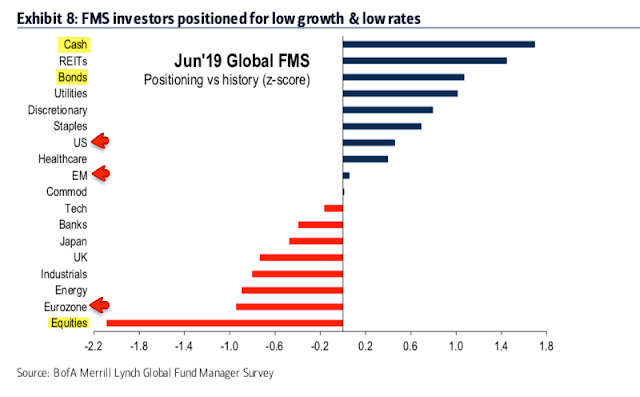
Cash: Fund managers' cash balance is extremely high at 5.6%, a big jump from 4.6% last month. BAML considers cash levels above 4.5% to be a contrarian buy for equities, and below 3.5% to be a contrarian sell.
This is supportive of further gains in global equities. Recall that in October 2016, fund managers' cash levels rose to 5.8% (similar to now). Global equities rose over 30% in the next year. In the past 15 years, cash allocations have very rarely been higher than now.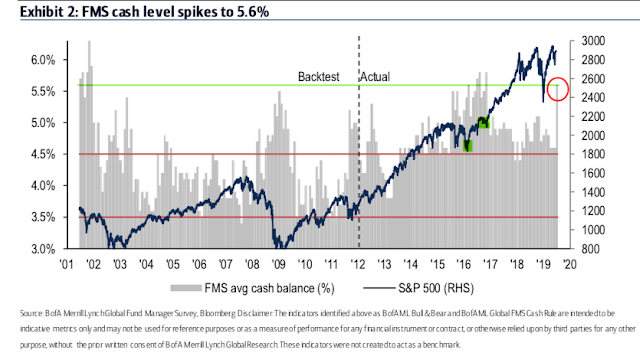
Likewise, fund managers are a net +43% overweight cash (+1.7 standard deviations above its long term mean). In the context of a bull market, cash should underperform a 60-30-10 basket (equity-bonds-cash).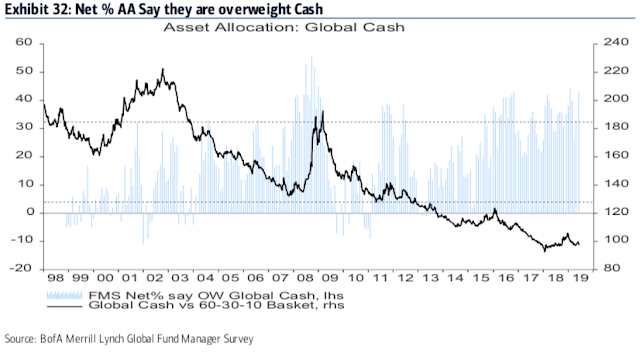
Global equities: Fund managers' global equity allocations plummeted to +21% underweight (-2.1 standard deviations below its long term mean) from +11% overweight last month. This is the lowest equity allocation since the bear market bottom in March 2009.
This is supportive of further gains in global equities, with bottoms in 2010, 2011 and 2016 at less extreme equity allocations. It is true, however, that allocations were even lower during the 2008 bear market.
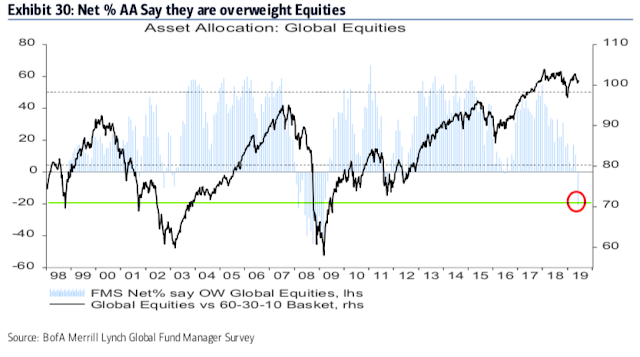
Equity allocations relative to bonds is likewise at an extreme not seen since the end of the bear market in 2009. In other words, fund managers have sold equities for the safety of bonds. This is consistent with the fund flow data presented earlier.
Global bonds: Fund managers are -22% underweight bonds, the highest allocation in nearly 8 years (+1.1 standard deviations above its long term mean).
Fund managers' bond allocation has been a less helpful indicator of performance. For one, fund managers are almost always underweight. Still, when fund managers have been less than -35% underweight (e.g., mid-2016 and early-2019), bonds have subsequently underperformed (red arrows). A contrarian would expect global bonds to underperform equities.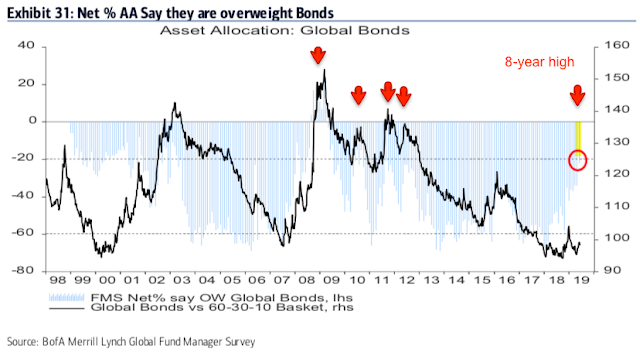
What is driving the shift from equities to bonds?
First, in November, 70% of fund managers expected higher inflation over the next 12 months; this was near a 14-year high. Since then, inflation expectations have collapsed by the largest amount since the 2011 (first chart). As in the past, a strong consensus view on inflation preceded a drop in U.S. 10-year yields in the following months (second chart).
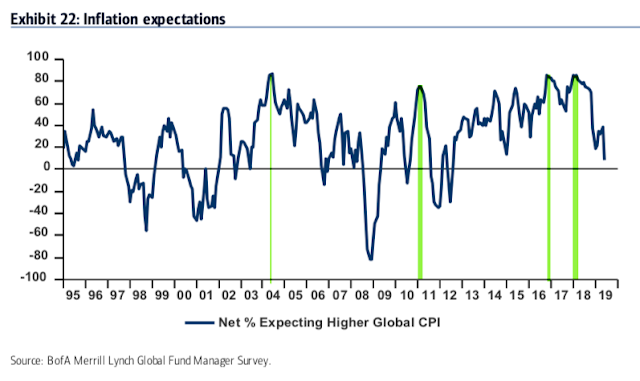
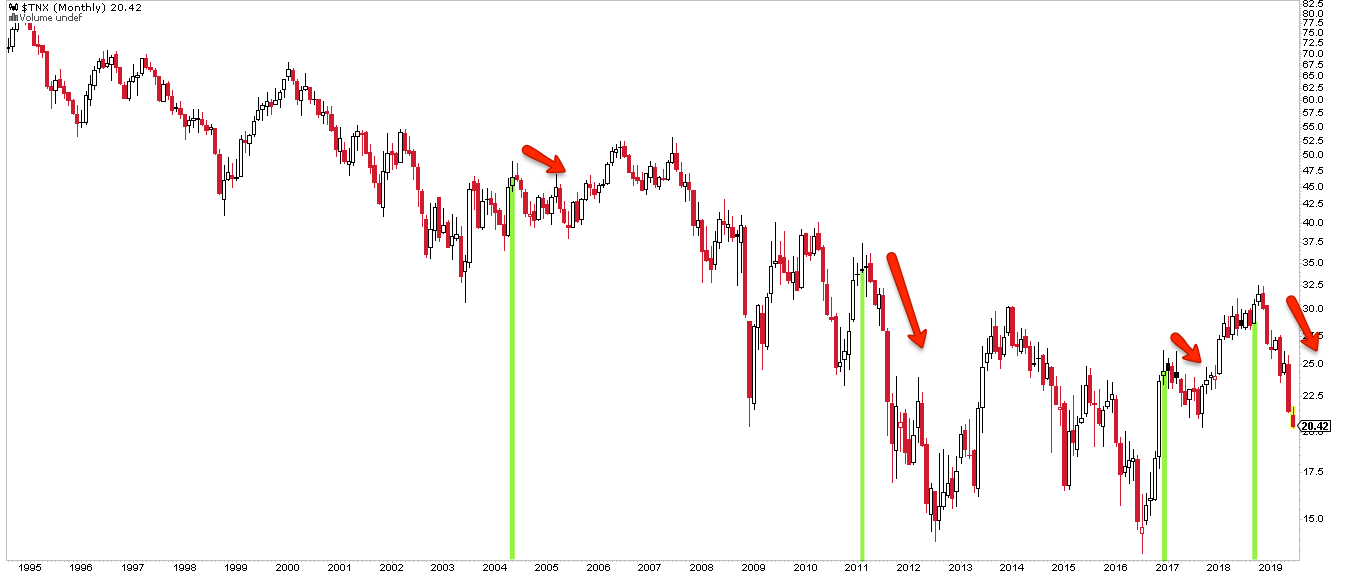
Second, fund managers are not bullish on profits, with a net -41% expecting a contraction in the next 12 months. Negative profit expectations marked equity lows in mid-2010, late-2011, mid-2012, early 2016 and January 2019, and earlier in 1998 and 2006. Like cash, it's true that profit expectations were even lower during the 2001 and 2008 bear markets.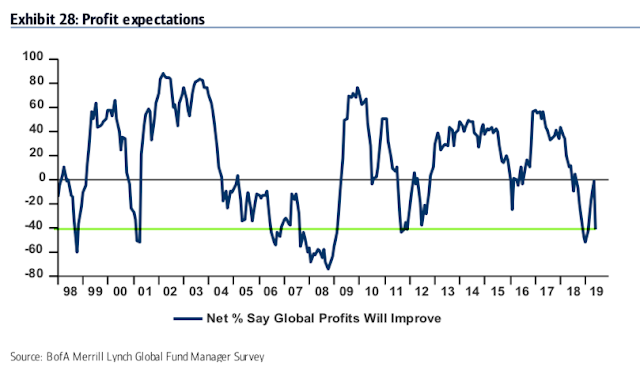
Similarly, a net -50% expect a better economy in the next year, near the lows in January. Investors are not bullish on the global economy: they are most often wrong, but were right in both 2000 and 2008.
Regional equities: Fund managers have only slightly increased their allocations to U.S. equities, to +5% overweight (+0.5 standard deviations above its long term mean).
On the one hand, the U.S. is now the 2nd most favored region. On the other hand, the region has not typically underperformed until allocations have been more than +15-20% overweight (e.g., December 2016 and November 2018; red arrows). Net, there is room for U.S. equities to rise further.
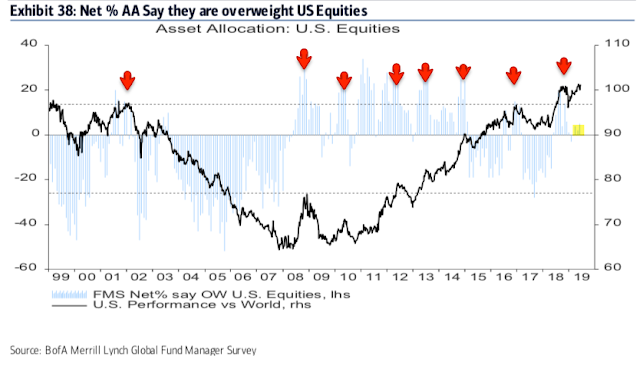
Fund managers are now -8% underweight European equities (-0.9 standard deviations below its long term mean), similar to the low in January (which was a 6-1/2 year low).
The region should outperform: when fund managers have been underweight, European equities have usually outperformed (green arrows) although that was not the case in 2008 and 2011 (red arrows).

Fund managers are +21% overweight emerging market equities (+0.1 standard deviations above its long term mean).
EM remains the consensus long although, relative to history, the current allocation is close to neutral. The region has usually started to outperform after fund managers drop their allocation to underweight (green arrows). A contrarian would expect the region to underperform.
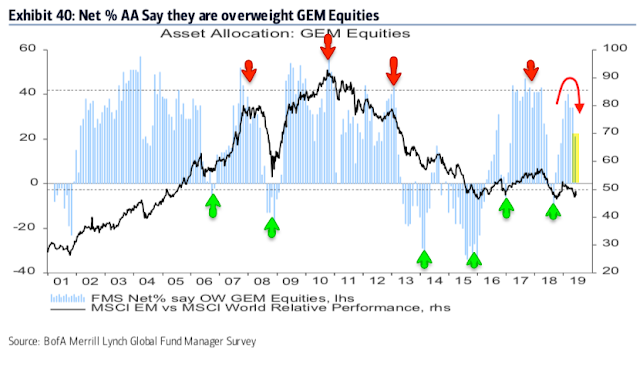
Dollar: The U.S. Dollar is considered the most overvalued in the history of the BAML survey (+2.1 standard deviations above its long term mean).
Since 2004, fund managers surveyed by BAML have been good at determining when the dollar is overvalued (red arrows); the last year has been an exception (green arrow). Risk is to the downside. A weaker dollar benefits U.S. multi-nationals as well as European and emerging markets equities.
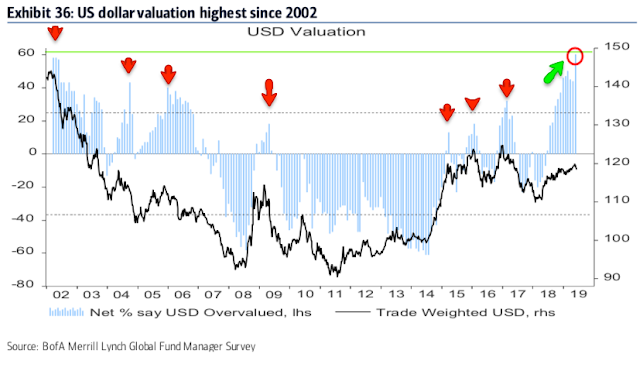
Survey parameters are below.
- Cash: The typical range is 3.5-5.0%. BAML has a 4.5% contrarian buy level but we consider over 5% to be a better signal. More on this indicator here.
- Equities: Over +50% overweight is bearish. A washout low (bullish) is under +15% overweight. More on this indicator here.
- Bonds: Global bonds started to underperform in mid-2010, 2011 and 2012 when they reached -20% underweight. -60% underweight is often a bearish extreme.
- Commodities: Higher commodity exposure goes in hand with improved sentiment towards global macro and/or inflation.
